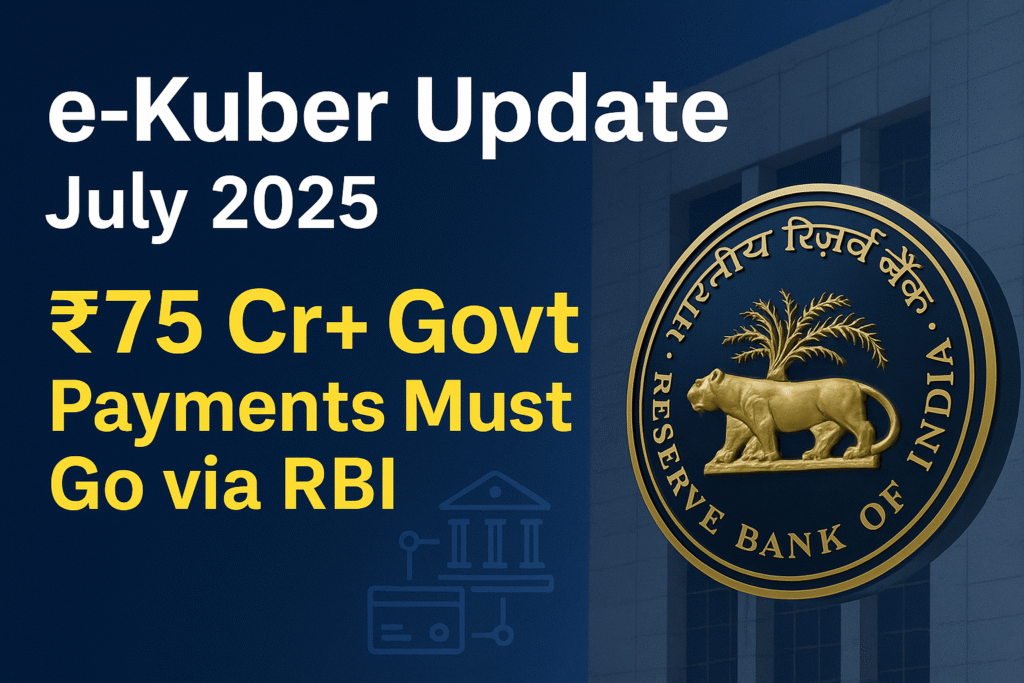e-Kuber July 2025 Update: RBI Mandates ₹75 Crore+ Government Transactions via Digital Treasury Platform
Starting July 16, 2025, the Reserve Bank of India (RBI) will require all central and state government payments exceeding ₹75 crore to be processed exclusively through its digital treasury system, e-Kuber. This landmark policy is set to revolutionize how large-value government transactions are executed in India.
🔍 What is e-Kuber? | RBI’s Core Banking System for Government Payments
e-Kuber is RBI’s centralised core banking solution designed to facilitate seamless, real-time, and transparent fund transfers for government departments and public sector entities.
🌐 Key Features of the e-Kuber Platform
- Real-time Gross Settlement (RTGS) for government transactions
- 360-degree visibility and audit trail of public fund flows
- Integration with Direct Benefit Transfer (DBT), GST, and other schemes
- Multi-layered cybersecurity and identity validation
- Interoperable APIs for government finance systems
More details: Official RBI e-Kuber System Guide
🚨 e-Kuber July 2025 Mandate | New Rule for High-Value Government Transactions
In a move to ensure greater transparency, efficiency, and control over large government transactions, the RBI announced that from July 16, 2025, all payments above ₹75 crore must be routed through e-Kuber.
Who is Affected by This Rule?
- All Central and State Government Ministries
- Public Sector Undertakings (PSUs)
- Government Agencies and Autonomous Bodies
🌟 Objectives Behind the Update
- Prevent misuse of large funds through digital traceability
- Foster digital governance and public finance reforms
- Eliminate delays caused by manual approvals and bank intermediaries
💡 Benefits of e-Kuber Integration | Modernizing Indian Government Fund Management
This policy is not just a compliance directive—it’s a step toward a smarter, digitized public finance system.
Top Benefits of e-Kuber for Government Payments:
- Faster Disbursements: Immediate fund transfer across accounts
- Improved Compliance: Digital audit trails and fund tracking
- Cost Efficiency: Reduction in intermediary banking charges
- Centralized Oversight: Ministry of Finance and CAG gain complete visibility
🧠 Expert Opinion: A Timely and Strategic Move e-Kuber July 2025 update
Having observed digital transformation in government finance, this policy brings India closer to a real-time, accountable treasury model. The RBI’s e-Kuber platform is scalable, robust, and already proven in use across states for DBT and salary disbursements.
⚙️ Challenges in Implementing e-Kuber Mandate | What Departments Must Prepare For
Key Implementation Hurdles:
- Legacy ERP systems not compatible with e-Kuber APIs
- Lack of trained IT personnel within departments
- Delays in integrating new digital workflows
Pro Tip: Engage with RBI tech support early and test system integration before the July 16 deadline.

📚 Related Resources & Readings
- How Digital Payments are Reshaping India’s Economy
- Digital Infrastructure 2025: India’s Public Finance Transformation
✅ Final Thoughts: e-Kuber July 2025 is a Leap Toward Digital-First Governance
With this e-Kuber update, RBI is reshaping how public money flows—replacing bureaucratic delays with digital clarity. Ministries, PSUs, and government finance teams must view this not as a burden, but as an opportunity to modernize their operations.
e-Kuber is India’s digital future in action—a move toward zero leakage, instant tracking, and smart fund governance.
📣 What You Should Do Next
- 💬 Leave a comment below: Is your department ready for e-Kuber?
- 🔗 Share this article with government accountants, PSU CFOs, and IT heads.
- 📰 Follow our blog for more updates on RBI policies and public finance trends.

